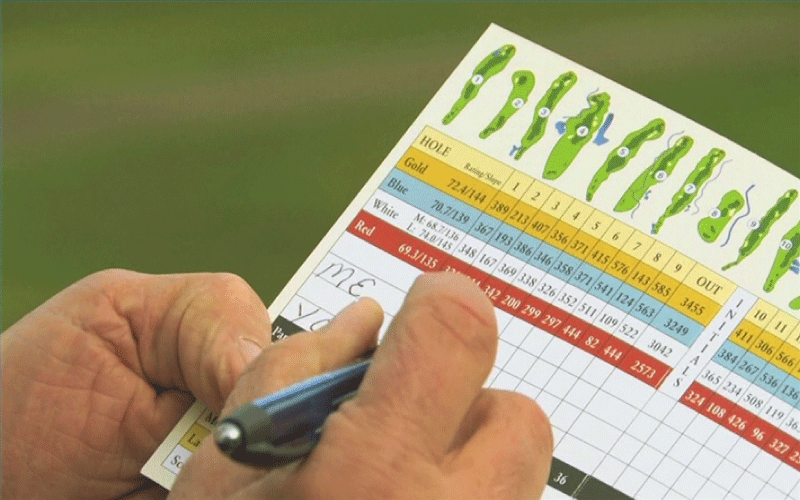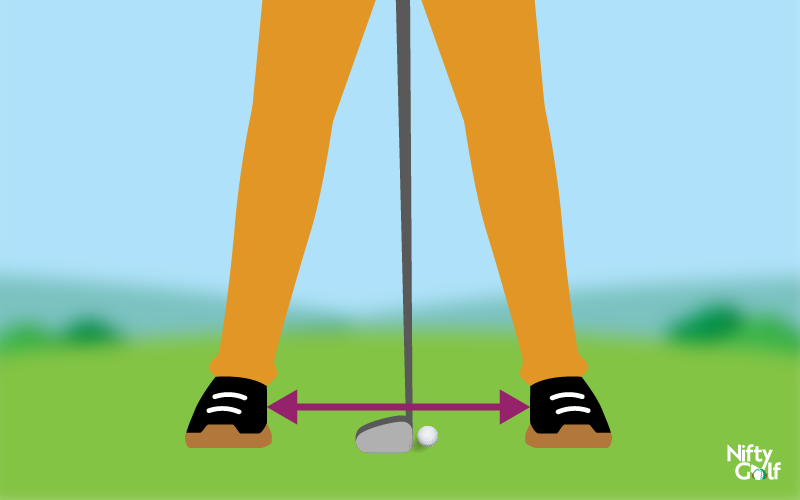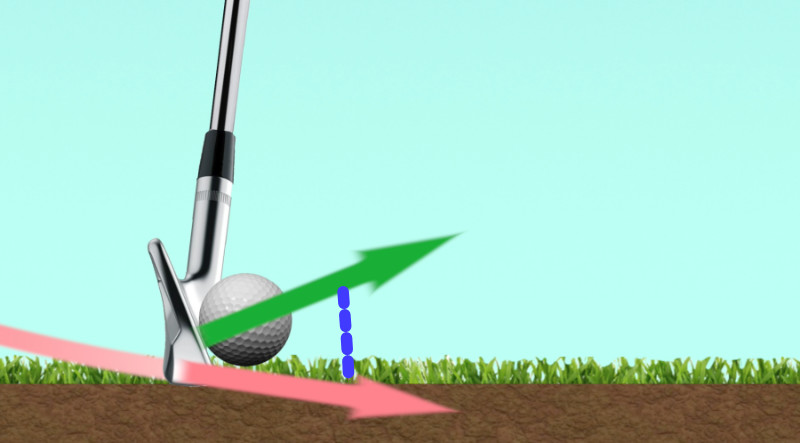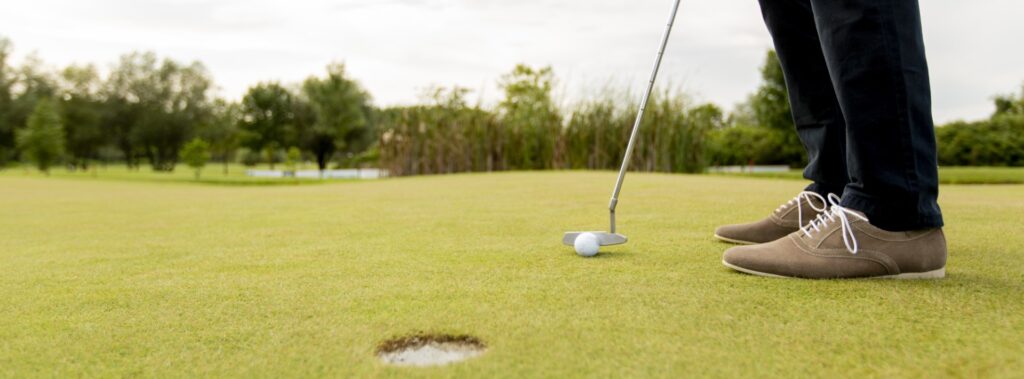Breaking 90 in golf is the magical milestone that is still a dream goal many golfers share. It gives the privilege to be addressed as an above-average golfer. Along with limiting your mistakes, you need to make a few new strategies too.
Breaking 100 in golf was the first step toward it, where the main goal was to reduce the number of double bogeys. Now to get 89 on your scorecard, you need to start targeting bogeys and a few pars too. It goes without saying that striking the golf balls just like you did before won’t be enough. You need to follow a proper process.
Elevate Your Game: 33 Key Tips to Score Under 90
Here are 33 tips to make the journey easier for you. So, without any further delay, let’s start walking toward the milestone of breaking 90 in golf.
1. Know your exact distances: Get a GPS or rangefinder

You need to hit a bit more accurate shots for a under 90 score. Thus, it is suggested to start practicing with a golf GPS or rangefinder to make more precise shots on courses later. Know your approximate distances after hitting with different clubs of your golf bag. Doing that before going to the golf course will lead you to make the shot plan and pre-shot routine more effectively.
A good news is that Distance Measurement Devices (DMDs) like rangefinders and GPS are allowed in golf courses. The United States Golf Association (USGA) has approved this rule in 2019.
2. Use forgiving clubs: Choose clubs that are more tolerant of mishits
Using forgiving golf clubs can help improve your game significantly. These clubs are designed with a low center of gravity to aid in achieving a higher launch and longer shots.
Game improvement irons, for example, are tailored to assist golfers in making more effective strokes, especially when they don’t hit the ball perfectly. The larger sweet spot on these clubs means mishits are less likely to go drastically off course, offering a more consistent game.
3. Golf shaft and swing speed: Match with your swing style and speed
Matching your golf shaft and swing speed is crucial for optimal performance. You need to consider the shaft material, flex, weight, shaft point, torque.
For example, steel shafts are best for faster swing speed and gain better feedback or accuracy. While the graphite ones are easier to use and control. If the shaft is too stiff or too flexible for your swing speed, it leads to inaccurate shots. Consulting a professional to find the right shaft flex is the best way.
4. Choose a suitable golf ball
The choice of golf ball is often overlooked but is crucial to break 90. Different golf balls have varying characteristics, such as spin, feel, and flight. For a golfer aiming to break 90, a ball that provides a good balance between distance and control is ideal.
To focus more on the short game, higher compression rated, 3-piece balls offer more advantage. But if you have a slower swing speed, distance golf balls are more beneficial for you. Experiment with different golf balls to find one that complements your playing style.
5. Make realistic shot plan: Target bogey and par

On average, you need bogey to break 90 in a 72 par, 18-hole golf course. No place for double bogey at all. More precisely, you need at least 17 strokes over the par to keep your golf score under 90. That means 17 bogeys and a par.
Target no less than 3 pars even if you are aiming to get an 89 score for now. Don’t keep the par for the last hole and get frustrated about it. Even if you make a par in the very 2nd hole, try to make 2-3 pars more. It’s to stay on the safe side. You never know when it may end up making 3-putts. And the bogey may end up in double-bogey at the very last hole.
6. Warm up before the round
Warming up is a must to prepare body and mind. It can significantly improve your performance and help you get closer to breaking that 90.
Start with some easy movement like jogging to raise the body temperature. Then, do golf stretches to loosen up your muscles, focusing on your back, shoulders, and hips. Proceed to hit some practice shots, beginning with your wedges and gradually working up to your driver.
This helps to get the feel for swings and adjust techniques if needed. Additionally, use this time to practice putting and chipping to get a sense of the greens.
7. Maintain a consistent pre-shot routine: Keep it simple

When you are walking down toward the tee box, that’s the very time to start your pre-shot routine. It lessens nervousness and lets you loosen up. No need to make it complicated. You might already have a pre-shot routine. Just make it slightly more refined to boost your confidence. Follow these simple steps-
Step 1: Divide the distance: Add the total distance before reaching the tee box. Because when you reach the tee box, you will have a hundred more things to check, like the alignments, ball position, shaft lean, posture, etc. So, calculate it before reaching there.
If the par-3 is 250 yards, target to hit a 150-160 yards drive. Then, a 50-60 yard pitch and 2 chips, each one covering 15-20 yards.
Step 2: Execute: Don’t take more than 15-20 seconds for a pre-shot routine. Execute the shot already. Taking more time may let negative thoughts get in. That will harm your game.
Step 3: Move on: The ball got in the bunker? Say “It’s okay” to yourself twice. Take the ball out of the bunker with a stroke. Target to make this up with a par in the next hole.
8. Address the ball and visualize
Before every shot, take a moment to address the ball and visualize the intended shot. This process includes positioning the golf ball, placing the clubface behind the ball, and creating a mental image of the trajectory and landing spot. This visualization technique helps in aligning your body correctly and mentally prepares you for the shot, leading to better focus and execution.
9. Tee shot: Avoid penalties

Keep in mind that you are not in a place to make a double bogey when you aim to shoot in the 80s. Along with the bogey, you will need a par too. So, there is no room for a penalty on the tee shots. Plan your game hole by hole.
When you are on par-4 of 300-330 yards, don’t pull out your golf driver or fairway woods. It will be very risky because both are for longer drives, like 210 yards or more on average. These clubs may make your ball end up in hazards or out of bounds. Instead, go for long golf irons like iron-3 or 4. Target to make a 180-190 yards drive. Rather than getting half the distance, getting no penalty is more important here.
10. Compensate for shot shape: Choke down on the grip
Choking down the club is simply gripping the clubs further down the shaft. Learning to choke down on the grip is useful for controlling shot shape and trajectory. This can be particularly helpful when making a more controlled, shorter shot or playing in windy conditions.
Adjusting your grip on the club allows for more precision, especially in challenging situations. It can help you avoid hazards and improve your scoring. Some might hesitate to do it because of the distance loss. However, it’s better to hit shorter than the balls going too much off the target.
11. Aim for the middle of the green
Aiming for the middle of the green is a safe strategy. This tactic reduces the risk of landing in hazards. By targeting the center, you allow for some margin of error in distance and direction, increasing your chances of staying on the green and potentially setting up a birdie or an easy par.
12. Learn how to scramble
Developing scrambling skills is crucial for recovering from challenging situations. Scrambling refers to your ability to score well despite missing the green or facing a difficult lie. It involves creativity and a good short game, especially chipping and putting under pressure.
13. Approach shot: Analyze before aiming the pin
As a 90s shooter, you may aim the pin sometimes. But you need to know when you can do it. 2 situations where you shouldn’t aim for the pin-
Situation 1: Not more than 100 yards away: If the distance between you and the pin is under 80 yards, you are safe to go for the approach shot. 100 yards is okay sometimes but still a bit risky. If it’s more than that, don’t go for it. We aren’t in a place to take this big risk.
Situation 2: Avoid Hazards: Drop the plan right away as soon as you see the pin is near water or out of bounds. It’s okay not to make a par. But making a double bogey or triple bogey or getting a penalty means you will need to do damage control in the next hole. The situation will get worse.
14. Focus on short game: Chipping and pitching is crucial
To break 90 in golf, you don’t need to learn any new short-game shots. Now, it is all about the time you put into practice, especially chipping and pitching is important. As short game shots are all about controlling the distance, do different drills.
Mark targets of 40 yards, 50 yards, and 60 yards away from you with chalk powder or baby powder. Now grab your pitching wedge. Or any of the short irons like iron-7,8 or 9. Then, strike different short game shots that you already know 10-20 times.
When you are done, now go for odd distances. Target for 45 yards, 53 yards, and 57 yards away. Practice another 10-20 times. Do this drill with different golf wedges to understand the impact of clubs on the distance.
15. Recovery shot: Master bunker and punch shots
Your first goal is to keep the ball away from the hazards. If that doesn’t work, which is pretty much common in golf, it is time for recovery. Knowing how to make the bunker shot and punch shot is enough for now.
Bunker shot

If we talk about the hazards and hindrances in the game, bunkers are one from the upper class. Give them some respect, especially the deep ones. Stay away from them. And sometimes, depending on the depth of the bunker, take relief. Add one penalty stroke and get your golf ball back in the previous place.
If you can’t make the way out of bunkers with 2 strokes, it’s better to accept the penalty. But when there are more chances of succeeding, go for it.
How to make a Bunker shot? (Step-by-step)
Step 1: Your sand wedge is the go-to wedge for bunker shots. Grab that.
Step 2: Dig a small amount of sand to stand stably.
Step 3: Put your weight on the front foot. The weight you put needs to be somewhere near 60%-80%.
Step 4: Let your arm fall right in front of you and make a V shape.

Step 5: Open the face club slightly.
Step 6: Don’t just aim the ball. Aim both the ball and sand behind it.
Step 7: Bend your wrist a little. Hit slightly behind the ball aggressively, making the ball and some sand come out together.
Punch shot
When you need to keep the ball lower to recover it from a difficult place, punch shots are for then. For example, when you need to make the ball go under tree branches. Or when you are in a strong crosswind, and you need to make a lower shot to have less effect of wind on the ball flight.
How to make a punch shot? (Step by step)
Step 1: Grab your iron-7 or 8 if you have slightly more space under branches. Take iron-4 when you need to make a really low shot.
Step 2: Position the ball in the middle of your stance. But for a low punch shot, place it in the back of your stance.

Step 3: Put most of your weight on your left-hand side and 60-65% of your weight on your front foot. Don’t move your lower body while making the shot. That may make the ball go off the target.
Step 4: Keep the clubface more closed if you target a lower shot.

Step 5: Make a shorter swing and focus more on the clean contact. The backswing needs to be shorter than usual. Make a three-quarter length backswing with a shoulder turn. Then strike.
16. Take your medicine
PGA Tour player Kyle Stanley went for the shot when it was tough even to see the ball. The shot wonderfully went to 15 feet. These stories are very inspirational to make you go for the shots and become a story among the friends group. But golf isn’t about going for it or taking the risk all the time. Nor are we Kyle Stanley.
It’s essential to take some risks like making a punch shot or aiming the pin sometimes. However, when the chances are very low to get through, playing smarter is what golf is about. At the end of the round, no one will remember that you took your medicine on the 5th hole. Instead, they will remember you couldn’t break 90. So, chuck it when you need to. Accept a bogey and get your ball back on the fairway by taking your medicine.
For example, your golf ball got stuck in the rough. Your next target has tree branches in between and bunkers on the side. If you go for it now, you may need to make both a punch and bunker shot. That would instead cause a disaster by making a double or triple bogey. In this situation, leave the idea of making a miraculous recovery shot and take relief.
17. Understand the green: Develop skills in reading greens for better putting
Reading greens effectively is vital for successful putting. Understanding the subtle contours, slopes, and grain direction of the green can help in predicting how the ball will roll. This skill requires practice and experience but can greatly improve your putting accuracy. Try reaching a specific target distance on different surfaces to understand it better.
18. 3-6 foot putts: May seem easy but isn’t

Target to make 18 two-putts at the beginning of the round. While breaking 90 in golf, short putts become a big headache, especially 3-6 foot putts. It is pretty frustrating when you go this close, and then you need another stroke to hole.
Like any other golf shot, more practice will gradually make it right. Follow these simple steps to make short putts successfully in the practice sessions and competitive rounds.
Step 1: Slow down. That’s the first step to making a successful short putt. Don’t rush to make the shot. Take a deep breath. Read the green.
Step 2: Focus on your putter face alignment first. It is the most common reason why golfers miss short putts. Even a slight difference defects the stroke path.
Step 3: Practice understanding the proper rhythm when you hit the sweet spot or near the putter’s sweet spot. A bad contact with the ball affects the direction and distance the ball travels after strokes.
Step 4: Bow forward from your hips and hang your arms naturally. Stay still till you make the stroke. Moving too much will make the stroke go wrong. Nervousness may make you move the body relatively more. You need to focus if you want to succeed.
Step 5: Practice to make a straight putt with one hand. This improves your grip on the club. And helps to reduce left or right misses while making putts.
Step 6: Correct the ball position. Golfers often forget these in pressure of putting it right. So, check it first. Don’t stand too far from the ball. That will make the ball off the hole.
Step 7: You need to put in less power for short putts. So, control your backstroke as it controls the power you put on the shot. It determines how far the ball will go. The shorter the putt is, the smaller the backstroke stroke needs to be. Then, strike.
You may use putting aids to boost up your putting skills.
19. Damage control: Nullify the misses
Having misses isn’t a sin in golf. Even the PGA tour players, best in golf like Tiger Woods, make multiple misses per round. So, there is nothing to worry about. At least not when you are targeting to break 90 only.
Just take responsibility for the misses. Nullify it or do damage control to ensure that the missed shot isn’t becoming your shot-plan hindering penalty.
Understand your mistakes first. Why is it happening? It’s different for different golfers. Try to find your misshit patterns. Do it in a practice session with a friend or coach. Ask them to examine your shots and note down the times when you missed. Or you may also use a golf launch monitor or golf simulator to track down your statistics to have a clearer view of your mistakes.
For example, if your shot typically goes on the right and that ends up into the rough; next time, target for the left side. This will make the shot go straight. But don’t do this for a long time. It is just for fixing the damage for the time being.
It may go wrong on course even after practicing and planning it properly. It’s okay. Don’t panic. If you have the ball in a difficult place that requires 2-3 strokes to get it back on the fairway, take your medicine. The misses that have led you to make double bogeys in the first 2 holes, target for pars in the next 2. So that the damage gets fixed.
20. Rely on your strengths to lead the way
Understanding and leveraging your strengths on the golf course is vital. If you’re good at long drives, use them to gain advantage on longer holes. If your strength lies in the short game, focus on accurate approach shots and solid putting. Avoid shots that you’re less comfortable with and plan your strategy around your best skills. By playing to your strengths, you minimize mistakes and capitalize on what you do best, increasing your chances of scoring below 90.
21. Finish strong: Focus on maintaining performance throughout the entire round
Maintaining your performance throughout the round is crucial. Often, golfers may lose focus or energy towards the end, leading to unnecessary mistakes. Focus on finishing strong, balancing your energy levels and maintaining concentration until the last putt. This includes managing your stamina, staying hydrated, and keeping your mental game sharp.
22. Enhance your sensory connection with the club during swings
Improving your sensory connection with the clubface can improve consistency. This involves being more aware of the club’s position throughout your swing, particularly at the point of impact. Developing a better feel helps in making adjustments mid-swing and aids in consistently striking the ball well.
Analyze the sound and vibration of the clubs when you hit good shots. The outcome visualization is also crucial. This increased awareness is important for fine-tuning your shots and achieving better results on the course.
23. Practice with purpose
For each practice session, choose one area to focus on and set realistic, measurable objectives. For instance, if working on putting, aim to sink a certain number of putts from various distances. Utilize drills that mimic game scenarios and track your progress over time. A focused 30-minute session can be more beneficial than hours of unfocused practice.
24. Clean your clubs: Maintain your equipment for optimal performance
Maintaining your golf clubs is crucial for consistent performance. Clean clubs ensure better ball control and accurate shots. Dirt or grass stuck in the grooves of a club can significantly alter the spin and trajectory of the ball.
Regular cleaning not just helps improve your performance but also extends your clubs’ life. Make it a habit to clean your clubs after each round or practice sessions.
25. Play familiar courses first
Playing the same courses allows you to gain strategic knowledge and experience with specific holes. Familiarity with the course layout, typical pin placements, and knowing how to navigate particular hazards or challenges can give you an advantage in planning your shots and strategy. This helps you notice the shortcomings easier and come up with better strategies.
26. Watch golf on TV
Watching professional golfers on TV can be more than just an enjoyable pastime. Paying attention to their technique, shot selection, and how they handle challenging situations can be quite beneficial. Also, listening to the commentary can offer insights and tips. By watching pros like Tiger Woods, Inbee Park, Rory McIlroy; you can gain new perspectives and strategies to apply to your own game, helping you inch closer to breaking 90.
27. Work with an instructor
Seeking professional aid can provide personalized tips and corrections that are specific to your game. An instructor can offer insights and adjustments that you might not notice on your own. Regular sessions with a coach can lead to significant improvements in your technique, strategy, and overall game.
28. Assess golf fitness
Your physical fitness plays a key role in your golf performance. Ensure your fitness level supports your golfing goals. This includes having the necessary strength, flexibility, and endurance to play your best golf. That helps to make a more realistic improvement plan.
29. Track your game: Analyze where and how you lose strokes
Keeping detailed records of your game, including fairways hit, greens in regulation, putts per round, and so on, provides a comprehensive analysis of your strengths and weaknesses. Analyze where and how you are losing strokes during a round. It can help identify areas for improvement. Whether it’s missing fairways, trouble with bunker shots, or three-putting, understanding these patterns allows you to focus your practice and strategies to minimize these losses.
30. Invest in Technology

Using gadgets and apps can offer valuable feedback and assist in skill development. Tools like swing analyzers, GPS devices, and performance tracking apps can provide insights that are not easily noticeable but can significantly impact your game.
31. Play with better golfers: Learn by competing and observing
Playing with better golfers is an excellent way to improve your game. Observing how they approach the game, manage the course, and handle pressure can provide valuable insights.
Notice their pre-shot routines, club selection, and how they read greens. Observe how they act in challenging situations. This can help you understand the strategic aspect of golf, which is essential for breaking 90.
Also, playing with better golfers often naturally raises your level of play. The competitive environment can motivate you to focus more and play your best golf. Ask questions or for advice, as most experienced golfers are happy to share their knowledge.
32. Read mental game books: Enhance the psychological aspect of your game
The mental game in golf is often as important as physical skills. Reading books focused on the psychological aspects of golf can significantly improve your performance. These books offer insights into managing emotions, maintaining focus, and developing a strong mental approach to each shot.
For instance, “Golf is Not a Game of Perfect” by one of the best sports psychologists, Dr. Bob Rotella, explores how to improve your mental game to dramatically lower your scores. Similarly, “Zen Golf: Mastering the Mental Game” by PGA coach and Buddhist instructor, Dr. Joseph Parent, provides techniques for staying calm and present.
By understanding and applying these mental strategies, you can learn to overcome common mental barriers like nervousness, fear, anxiety and frustration, which often prevent players from breaking 90. Start by dedicating a portion of your practice time to mental game exercises like visualization or mindfulness techniques. Remember, a strong mental game can often compensate for physical limitations on the course.
33. After Match: Be Consistent
Find out your weakness. See what makes it the hardest for you to reach the 89 score. Practice that hole again and again where you almost made a double bogey. Keep trying unless you make it. It’s not anything that you can’t. You are already a respectable 90s shooter. A few strokes less is not anything impossible for you.
And if you have successfully broken 90 after all this hard work, congratulations! You so deserve that. Now, keep breaking 90 consistently to make your average score under 90. Scoring 89 once won’t make that happen. So, keep going.
Conclusion
Reaching the milestone of consistently scoring below 90 in golf is a realistic goal for those who have already broken 100 in golf. And if you have already broken 100, that means there is no significant error in your basics. What you need to do now is to level up your game by following a few tips. That’s what we have put together in this article.
Remember, breaking 90 is not just about physical skills; it’s about strategy, mental strength, and consistent effort. Stay motivated, practice diligently, and integrate these tips into your gameplay to achieve your first score of 89 and beyond.
Feel free to leave any question in the comments section. It would be our pleasure to be a part of your breaking 90 journey.
Happy golfing!

